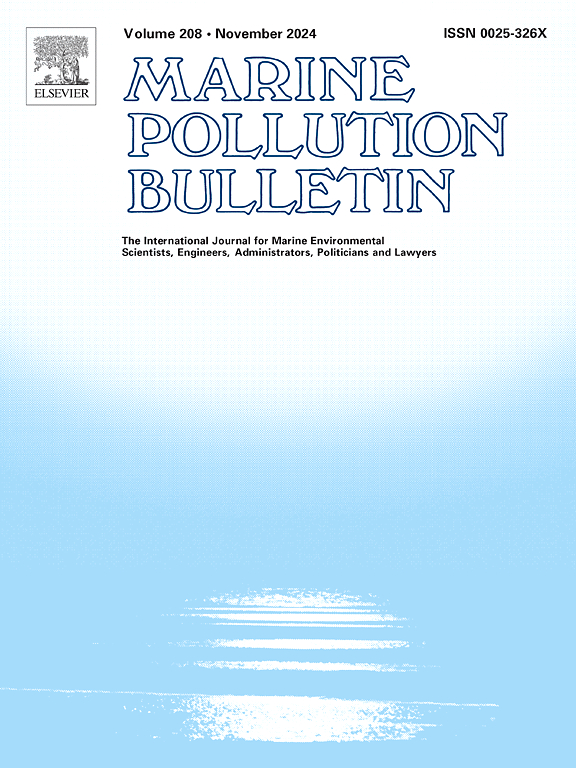来自印度临床和沿海环境来源的抗生素抗性弧菌物种的基因组见解
IF 4.9
3区 环境科学与生态学
Q1 ENVIRONMENTAL SCIENCES
引用次数: 0
摘要
沿海水域致病性弧菌的发生和影响受到海洋变暖、海平面上升和极端天气事件等气候变化指标的强烈影响。本研究旨在比较印度沿海地区临床和环境来源的霍乱弧菌的毒力和耐药性(AMR)谱。我们还研究了其他海洋弧菌的致病特性。我们假设来自不同环境的弧菌会表现出不同的毒力和AMR模式,这是由它们的生态环境决定的。为了研究这一点,我们对临床和环境分离株进行了抗生素敏感性试验和全基因组测序(WGS)。我们的研究结果表明,来自沿海水域的环境霍乱弧菌具有促进宿主粘附和溶血活性的基因。同样,溶藻弧菌和创伤弧菌也含有毒力因子,帮助组织附着和侵袭。耐药性分析显示,环境霍乱弧菌对氟喹诺酮类和大环内酯类耐药,而临床分离菌株对氨基糖苷类和磺胺类耐药。海洋环境中耐抗生素弧菌的存在构成了重大的公共卫生风险,特别是考虑到人类经常与沿海水域进行娱乐、捕鱼和运输。气候变化可能加剧这些病原体在水生和陆地系统中的扩散和移动,增加人类接触的可能性。此外,耐药基因可能在致病性海洋细菌之间横向转移,这进一步突出表明需要制定监测和缓解战略,以应对海洋生态系统中抗菌素耐药性日益严重的威胁。本文章由计算机程序翻译,如有差异,请以英文原文为准。

Genomic insights into antibiotic-resistant Vibrio species from clinical and coastal environmental sources in India
The occurrence and impact of pathogenic Vibrio sp. in coastal waters are strongly influenced by climate change indicators such as ocean warming, sea-level rise, and extreme weather events. This study aimed to compare the virulence and antimicrobial resistance (AMR) profiles of Vibrio cholerae from clinical and environmental sources across India's coastal regions. We also examined pathogenic traits in other marine Vibrio sp. We hypothesized that Vibrio spp. from different environments would show distinct virulence and AMR patterns shaped by their ecological context. To investigate this, we conducted antimicrobial susceptibility testing and whole-genome sequencing (WGS) on both clinical and environmental isolates. Our findings reveal that environmental V. cholerae from coastal waters possess genes promoting host adhesion and haemolytic activity. Similarly, Vibrio alginolyticus and Vibrio vulnificus harboured virulence factors aiding tissue attachment and invasion. Resistance profiling showed environmental V. cholerae were resistant to fluoroquinolones and macrolides, while clinical isolates were resistant to aminoglycosides and sulphonamides. The presence of antibiotic-resistant Vibrio in marine environments poses a significant public health risk, especially given frequent human interactions with coastal waters for recreation, fishing, and transport. Climate change may exacerbate the proliferation and movement of these pathogens across aquatic and terrestrial systems, increasing the likelihood of human exposure. Moreover, the potential for horizontal gene transfer of resistance genes among pathogenic marine bacteria further highlights the need for surveillance and mitigation strategies to address the growing threat of AMR in marine ecosystems.
求助全文
通过发布文献求助,成功后即可免费获取论文全文。
去求助
来源期刊

Marine pollution bulletin
环境科学-海洋与淡水生物学
CiteScore
10.20
自引率
15.50%
发文量
1077
审稿时长
68 days
期刊介绍:
Marine Pollution Bulletin is concerned with the rational use of maritime and marine resources in estuaries, the seas and oceans, as well as with documenting marine pollution and introducing new forms of measurement and analysis. A wide range of topics are discussed as news, comment, reviews and research reports, not only on effluent disposal and pollution control, but also on the management, economic aspects and protection of the marine environment in general.
 求助内容:
求助内容: 应助结果提醒方式:
应助结果提醒方式:


